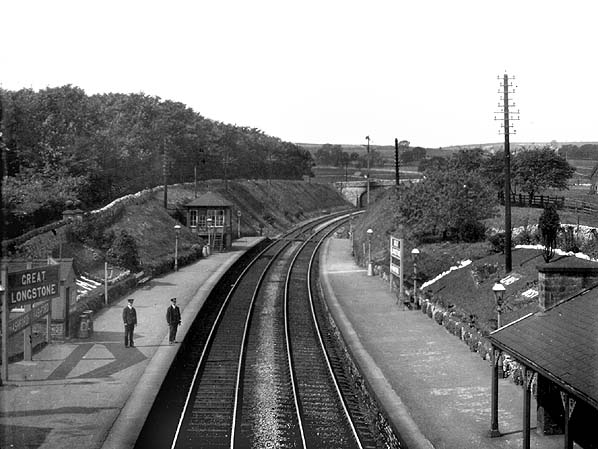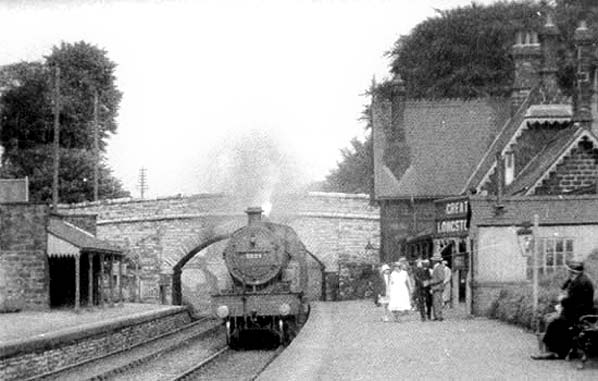Notes: Longstone Station was situated on what became the Midland Railway’s (MR) main line between Ambergate and Manchester Central.
 |
The station opened on the 1st of June 1863 as Longstone on a MR line that had been authorised in May 1860 and completed from Rowsley to Hassop by that date. Ever since the 1840s there had been a desire by the MR to reach the important industrial town of Manchester. Inter company rivalry, finance and landowner objections had all delayed things and it was |
only the possibility that rival companies might build a route between Derby and Manchester that finally moved the MR to get their Act of 1860. The line between Rowsley and Buxton was only the first stage though as on the 1st February 1867 a further line opened from Blackwell Mill to New Mills. This gave the MR a route stretching all the way to Manchester which it had long desired. Great Longstone Station was now part of a main line that stretched from London to Manchester.
| Longstone Station was located to the south of its village namesake and to the north of Ashford in the Water both of whose communities the station served. Situated on the west side of a road overbridge that carries the Ashford to Great Longstone road across the line the station had two platforms. The main station building, a two storey stone built structure, designed by |
 |
W H Barlow who was responsible for the MRs St Pancras station in London, stood on the northbound platform. The station building was designed to complement Thornbridge Hall which stood adjacent to the northbound platform. When the station was built the hall was the home of George Marples a director of the MR. Mr Marples was provided with his own set of steps that linked his home to the northbound platform.
The station building was linked to the road by its own approach road which also gave access to Thornbridge Hall. The station building had a canopy on the platform which protected passengers from the elements. The Southbound platform was connected to the road by a set of steps. Passengers wanting to cross the line from the booking office to the southbound platform used the public road and then descended onto the platform via the steps. A canopy was provided on the southbound platform but there was no building.
 |
Initially, the station was just served by trains that ran between Derby and Buxton. Only 4 of the 8 trains in each direction called at Longstone (plus both Sunday trains in each direction) in the initial timetable. Longstone was now served by trains running to and from the great industrial powerhouse of Manchester. Great Longstone mostly handled traffic of a local |
nature in particular services between Derby and Manchester or Buxton. The station never had goods facilities.
On the 1st October 1913 the station was renamed as Great Longstone for Ashford. In 1923 Great Longstone became part of the London Midland Scottish Railway (LMS) and although that company found itself with two routes between Manchester and London, the other being the former LNWR route, Great Longstone remained as important as it had been in MR days.
Although a very quiet station Great Longstone won many awards for the standard of its facilities and for its floral beds and decorations.
| In January 1948 Great Longstone for Ashford became part of the nationalised British Railways (London Midland Region). Because Great Longstone Station did not earn very much revenue it was closed to passengers on the 10th September 1962. One of the conditions attached to the closure was that the station had to be available for the use of a local Nursing Sister |
 |
whenever she needed to take a train to Buxton where she worked. The facility ceased when local stopping services between Matlock and Buxton/Manchester were withdrawn from 6th March 1967 with the last train running on 4th March.
The line through Great Longstone was considered for electrification in the early 1960s. It therefore came as a surprise when the line and all of the stations between Matlock and Chinley were earmarked for closure in the 1963 Beeching Report. Through freight and parcels traffic was withdrawn on 3rd October 1966 and the remaining stations on the line closed on from 6th March 1967 which would have been the last time the Nursing Sister could have used the station. Express passenger services continued to pass through until the 1st July 1968 after which the line from Matlock to Peak Forest Junction closed completely. Track lifting began in 1969.
 |
Great Longstone stations building and its platforms have survived closure and the building is now in use as a private residence. In 1982 the Peak District National Park established the Monsal Trail, a long distance path that uses many miles of the former MR route including the section that passes through Great Longstone station. |
Sources: Lost Railways of Derbyshire by Stan Yorke. Published by Geoffrey Kingscott & The Monsal Trail then and now by Alistair Lofthouse – Ald print.
Other web sites: Peak Rail now providing a regular steam service between Matlock and Rowsley. David Hey's Collection - Transition from BR steam. Includes railway photographer ER Morten's photographic tour from Buxton - Derby.
Eight and a half miles of the Matlock - Buxton line now forms the Monsal Trail starting at Coombs Road Viaduct, one mile southeast of Bakewell and finishing at the head of Chee Dale, about three miles east of Buxton. There is a diversion round the tunnels.
Note that the station was never officially called Great Longstone – although that version appeared on tickets from LMS days and it was certainly known by this shortened name in later years. Locals actually referred to it as just “Longstone”. It opened as Longstone, and was renamed Great Longstone for Ashford on 1st October 1913.
Further reading: Railway from Buxton to Bakewell, Matlock and Ambergate (Scenes from the Past) by JM Bentley, 1992. Railways around Buxton by JM Bentley, 1987.
Additional source Glynn Waite. Tickets from Michael Stewart, route map drawn by Alan Young
To see other stations between Manchester Central & Matlock click on the station name: Manchester Central, Chorlton-cum-Hardy, Withington & West Didsbury, Didsbury, Heaton Mersey, Cheadle Heath, Hazel Grove (Midland), Buxworth, Chinley (2nd site) STILLOPEN, Chinley (1st site), Chapel-en-le-Frith Central,
Peak Forest, Cheedale Halt, Buxton (Midland), Blackwell Mill Halt, Millers Dale, Monsal Dale, Hassop, Bakewell, Rowsley (Second site), Rowsley (First site), Rowsley South PEAK RAIL, Darley Dale, Matlock Riverside PEAK RAIL & Matlock STILL OPEN. See also Stockport Tiviot Dale & Stockport Portwood |




longstone_old1.jpg)
ongstone_old5.jpg)
longstone_old7.jpg)
longstone11.jpg)
longstone1.jpg)
potter12.jpg)
longstone5.jpg)








longstone_old_thumb8.jpg)
longstone_thumb14.jpg)
longstone_thumb15.jpg)
longstone_thumb16.jpg)
longstone_thumb18.jpg)
longstone_thumb1.jpg)
longstone_thumb3.jpg)
longstone_thumb4.jpg)
longstone_thumb13.jpg)
potter_thumb12.jpg)
longstone_thumb6.jpg)
longstone_thumb7.jpg)
longstone_thumb8.jpg)
longstone_thumb9.jpg)
longstone_thumb14.jpg)

 Home Page
Home Page